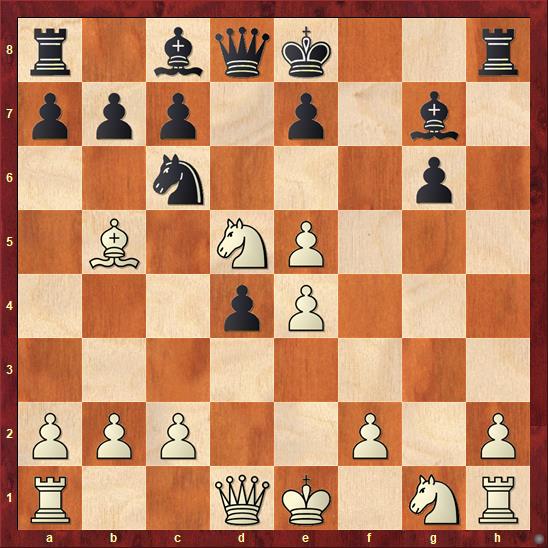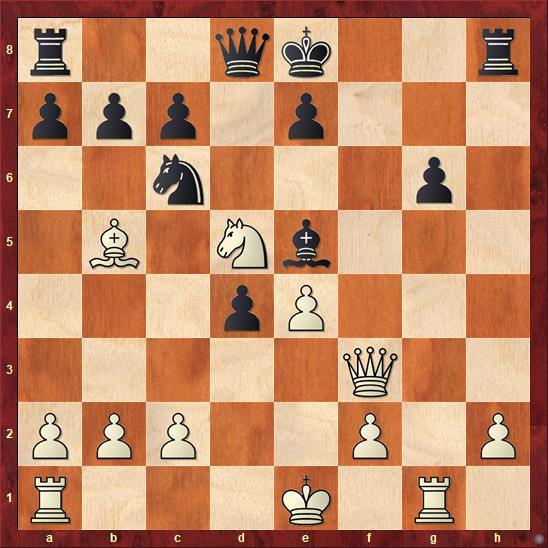There’s a saying that I’m really starting to like: “Long think, wrong think.” In game after game, both against the computer and in tournaments, it seems as if my weakest moves are the ones I take the longest on. A long think is usually a sign that I’m trying to talk myself out of the move my gut tells me to play. The longer I take, the more likely I am to go against my gut, because otherwise, what was the use of taking all that time?
An irony that often happens with long thinks is that the actual move I end up playing is not well thought out at all. Typically what happens is that my instinct tells me to play move A. But I see something that I don’t like about it; sometimes with good reason and sometimes not. But once I decide not to play move A, I very often play move B without really thinking about it — certainly without thinking as hard as I did about move A.
Of course, this faulty thinking pattern is well known; I’m pretty sure that it comes up in Kotov’s Think Like a Grandmaster. Even so, it’s something I fall prey to over and over again.
Here’s a really extreme example, from a game I played against my computer a few days ago. The game is so short I’ll show you the whole thing. Warning: Prepare to cringe.
Fritz 17 — Dana, 40 moves in 10 minutes
1. d4 Nf6 2. Nc3 d5 3. Bf4 …
This variation, the Jobava Variation, is practically the only opening Fritz plays that’s a real opening. Usually it plays crazy stuff. In this game, for a change, I get to play the crazy stuff.
3. … Nh5
I prepared this for my game against Paulo Santanna in the Kolty Club championship and it worked pretty well. Fritz plays it very differently from Paulo, who played 4. Bg5.
4. Be5?! …
I don’t think this is actually good, but it’s very tactical and that’s what Fritz loves.
4. … f6 5. e4 g6 6. g4 fe 7. gh Nc6 8. de d4 9. Nd5 Bg7 10. hg hg 11. Bb5 …

FEN: r1bqk2r/ppp1p1b1/2n3p1/1B1NP3/3pP3/8/PPP2P1P/R2QK1NR b KQkq – 0 11
Who knows if any of these moves are right? I think Black is doing pretty well, but in a semi-random position like this, it’s harder for a human to orient himself than it is for a computer. Sure enough, I start going wrong here.
11. … Bxe5?!
Too materialistic! Fritz prefers 11. … O-O. Development first, material second! The point is supposed to be that 12. f4 is met by 12. … Nxe5! 13. fe c6. One very entertaining line found by Fritz is 14. Bc4 cd 15. ed b5! 16. Bb3 Qa5+ 17. Qd2 Rf1+! deflecting the king away from the queen. Of course I never would have found this, but it shows that White’s position is every bit as loose as Black’s and maybe even more so.
12. Nf3 Bg4 13. Rg1 Bxf3 14. Qxf3 …

FEN: r2qk2r/ppp1p3/2n3p1/1B1Nb3/3pP3/5Q2/PPP2P1P/R3K1R1 b Qkq – 0 14
Here it seems to me that Black has an extremely obvious move. The g6 pawn is under attack, so I should defend it, right? So I was all set to play 14. … Qd6. But then the “long think” virus started to get to work on my mind. The trouble is that after 14. … Qd6 15. Qg4, I could not see any way to get my king to safety. But the computer says I don’t need to worry about that. Black’s plan is to play … Bxh2, … a6, … b5, and … Ne5, holding everything together. If White tries to prevent this plan by playing Qxg6+ at some point, Black says fine and trades queens.
But I just couldn’t work up the nerve to keep my king in the center. After 2 minutes of thought — an eternity in a 10-minute game! — I played 14. … Qd7?? “I’m giving up a pawn but at least I get my king to safety,” I thought. “And besides, his h-pawn is a goner, so I won’t even be down in material.”
This was the extent of my analysis of 14. … Qd7. After 2 minutes thinking about 14. … Qd6, I played 14. … Qd7 with, like, 5 seconds of thought. This is the classic “long think, wrong think” pattern.
Oh, by the way, can you work out what is wrong with my move?
14. … Qd7?? 15. Rxg6 O-O-O??
“Whew!” I thought. “Made it to the promised land!”
16. Rxc6! …
You know, sometimes playing against your computer is like having your own personal Paul Morphy. Stuff like this just comes at you out of the clear blue sky. I could have resigned here but I decided to play it out, just so I could say I got mated in less than 20 moves.
16. … bc 17. Ba6+ Kb8 18. Qb3+ Ka8 19. Qb7 mate.
There’s something almost sadistic about this game, the way that I thought I had solved all of my problems only to step right into a mating net.
Lessons learned: 1) Don’t use 20 percent of your time on one move. 2) Sometimes the obvious move is the right move. Just do it. 3) Sometimes your king is actually safer in the center than anywhere else. Especially if he has a lot of active pieces to defend and create counterthreats. “I get by with a little help from my friends.”



{ 1 comment… read it below or add one }
I played in a local tournament last weekend, using Zoom for communication and chess.com as the play mechanism. I found out Saturday night, to my surprise, that while I was sitting in glorious isolation in my basement, my coach was watching all of my games! He wrote to me after round 2 that not only was I playing too fast, but just about every time I took more than 2-3 minutes to move, I made a bad move. He speculated that I was second-guessing myself. I thought, though, that I took more time on those moves because I didn’t like any of my options–I wasn’t disregarding my intuition, my intuition wasn’t coming up with anything. In any case, it fit your long think/wrong think maxim quite well.
All parties made a lot of blunders, likely more than we would have face to face; when the dust cleared I’d won it 3.5/4, though my last-round opponent should really not have offered a draw as he was much better (but intimidated, he said, and maybe he knew his own energy level best).